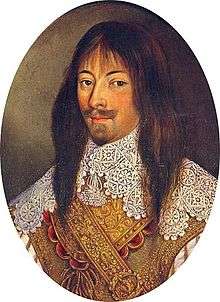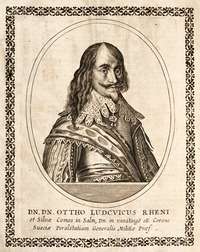Battle of Willstätt
The Battle of Willstätt was fought during the Swedish phase of the Thirty Years' War near the Free city of Strasbourg, in the Holy Roman Empire. Having dealt a heavy defeat on the Swedish army at the Battle of Nördlingen in September, the armies of the Emperor, Spain and the Catholic League overran much of the Swedish-held southern Germany. At Wilsttätt, the armies of the Emperor and the Catholic League, led by Duke Charles IV of Lorraine and general Johann von Werth, defeated a Swedish force assembled by the Germans the Rhingrave of Salm-Kyrburg-Mörchingen, the Duke of Württemberg and the Margrave of Baden-Durlach. The battle lasted for three hours and ended with 2,000 Swedish soldiers dead on the battlefield and a bigger number in the rout. The Rheingrave Otto saved himself inside Strasbourg.
| Battle of Willstätt | |||||||
|---|---|---|---|---|---|---|---|
| Part of the Thirty Years' War | |||||||
| |||||||
| Belligerents | |||||||
|
Heilbronn League |
| ||||||
| Commanders and leaders | |||||||
| Rheingrave Otto Louis |
Charles IV of Lorraine Johann von Werth | ||||||
| Strength | |||||||
| 6–7,000 infantry and cavalry[3][4] | 3,000 cavalry and 1,500 infantry[3][4] | ||||||
| Casualties and losses | |||||||
| 5,000 killed or captured,[3][4] plus 6 cannons and 4 flags[5] | Minor | ||||||
 Willstätt Location within Upper Rhine region  Willstätt Willstätt (Germany) | |||||||
Background

After the battle of Nördlingen, which saw the destruction of the main Swedish field army at Germany and the capture of its commander, Gustav Horn, the Catholic armies gathered for the battle divided again and advanced northwards to the lands occupied by the Swedish or held by their German allies. While the bulk of the Imperial and Spanish armies advanced upon Franconia, where Duke Bernhard of Saxe-Weimar, commander of the German Protestant forces, had withdrawn to defend the province following his defeat, Duke Charles IV of Lorraine invaded the duchy of Württemberg, a wealthy country where his troops could recover from the battle, and the commander of the German Catholic League, Johann von Werth, invaded and took control of Swabia.[4]
Aiming to expel the remaining Swedish forces from the Rhineland, Maximilian I of Bavaria asked Ferdinand II, Holy Roman Emperor, for some reinforcements.[5] Thus, Ferdinand sent Charles of Lorraine with an army corps to Alsace, where the Swedish, in order to prevent the Imperials from taking control of the region, were handing to France, under the terms of the Treaty of Paris, the fortresses and cities that they controlled there.[4] Meanwhile, Johann von Werth advanced on the Black Forest with the Catholic League's army and forced Duke Eberhard III of Württemberg to leave the siege of Willingen, chasing later his retreating forces to the gates of Strasbourg. While Werth went to join forces with Duke Charles, the Duke of Württemberg did the same with the governor of the Swedish Alsace, the Rhingrave Otto, who was collecting the Swedish forces at the Free Imperial city of Offenburg, on the eastern bank of the Rhine, opposed to Strasbourg.[4]
Battle

On 27 September both armies moved to meet each other at the battlefield near the village of Willstätt, between Offenburg and the Rhine river. The Catholics mustered 6 regiments of cavalry, 2 of croats and 300 musketeers, in all about 3,000 cavalry and 1,500 infantry, while the Swedish, having collected their forces from Swabia and the Bodensee, numbered 6,000 or 7,000 men, including the troops of the Duke of Württemberg and the Margrave of Baden-Durlach, asides of French reinforcements that were expected to arrive very soon to the battlefield under colonel Batilly, the lieutenant of the Duke of Rohan –sent by Louis XIII of France to assist the Swedish–, but which arrived late to see any action.[4]

The battle lasted for three hours, until Charles of Lorraine led an attack that broke the regiment of the Rheingrave, the best of the Swedish army, and the entire Protestant contingent was put on flight. About 2,000 Swedish soldiers were killed on the battlefield, and many others died during the chase or were drowned in the Rhine while attempting to escape. A group of 700 Swedish soldiers entrenched themselves inside a farmstead and perished amidst the flames after the building was set on fire by Catholic soldiers.[4] The Imperial and Leaguist forces took 6 cannons and 4 flags.[5]
The Rheingrave was about to cross the Kinzig, a stream which runs next to Willstätt and flows into the Rhine at Kehl, when he ran into some Bavarian cuirassiers of the regiment of Keller, who mistook him for a Catholic officer. Though they realized the mistake when the Rheingrave jumped into the water with his horse and opened fire on him, he only received a light wound.[5]
The Rheingrave managed to reach Kehl, where he entrenched his remaining men, and sent his family to Strasbourg across the town's bridge over the Rhine. On arriving there, Charles of Lorraine took the entrenchments by assault and the Rheingrave barely escaped.[5] However, the bridge collapsed shortly after because of the excessive burden of his fleeing soldiers, and many of them were drowned. Charles of Lorraine wrote a letter to the city council of Strasbourg, asking them to open the gates of the city, but the request was denied. The Rheingrave, still controlling the west bank of the Rhine, promptly retreated to Seltz, while the Catholics moved to Rastatt.[4] As result of the battle, the village of Willstätt was burned.[6]
Aftermath
Sweden and the Heilbronn League quickly removed their garrisons in the Rhineland after the battle and handed to France the cities of Colmar, Schlestadt and Basel. The Elector of Saxony opened talks with Ferdinand II, but the Landgrave of Hesse-Kassel and the Duke of Lüneburg still fielded troops against the Emperor and were in the surroundings of Frankfurt am Main. Meanwhile, the Imperial armies were between the rivers Neckar and Main, where they took Heilbronn on 27 September, the same day that the battle of Willstätt was fought.[4] Since the battle of Nördlingen, the Catholics had expelled the Swedish and their German allies from Bavaria, Swabia –except from Ulm and Augsburg, where they still held out but blockaded by the Duke of Bavaria–, Württemberg, and most of Franconia; in words of Diego Aedo y Gallart, secretary of the Cardinal-Infante Ferdinand of Austria: "expelling him [the Swedish] from the roots of the Alps".[3]
References
- Rebitsch, Robert: Matthias Gallas (1588–1647): Generalleutnant des Kaisers zur Zeit des Dreissigjährigen Krieges ; eine militärische Biographie. Münster: Aschendorff, 2006, ISBN 9783402065761, p. 123.
- Lahrkamp, Helmut: Jan von Werth: sein Leben nach archivalischen Quellenzeugnissen. Cologne: Verlag Der Löwe, 1962, p. 40.
- Aedo y Gallart, Diego: Viaje del Infante Cardenal don Fernando de Austria: desde 12 de abril 1632 que saliò de Madrid... hasta 4 de Noviembre de 1634 que entró en la de Bruselas. Amberes: Juan Cnobbart, 1635, pp. 170–171.
- Des Robert, Ferdinand: Campagnes de Charles IV duc de Lorraine et de Bar, en Allemagne, en Lorraine et en Franche-Comté, 1634–1638, d'après des documents inédits tirés des archives du Ministère des affaires étrangères. París, Nancy: H. Champion; Sidot Frères, 1883, p. 46–47
- Schreiber, Friedrich Anton Wilhelm: Maximilian I. Der Katholische, Kurfürst von Bayern und der dreißigjährige Krieg: Nach den Acten und Urkunden der k. B. Allgemeinen Reichs-, Staats- und Provincial-Archive. Munich: Fleischmann, 1868, pp. 660–661.
- Pfaff, Fridrich: Alemannia: Zeitschrift für sprache, litteratur und volkskunde des Elsasses und Oberrheins. Freiburg im Breisgau: Ernst Fehsenfeld, 1907, p. 193.